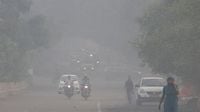Delhi’s autumn air crisis has once again set the capital on edge, as residents awoke on October 27, 2025, to a city shrouded in thick, gray smog. The Air Quality Index (AQI) for Delhi stood at 315, firmly placing it in the ‘very poor’ category for the second consecutive day, according to the Central Pollution Control Board (CPCB) data reported by The Economic Times. Neighboring cities fared no better: Noida’s AQI hit 331, Ghaziabad registered 321, and Greater Noida and Gurugram recorded 288 and 244 respectively—each figure spelling trouble for the lungs of millions. Only Faridabad, with an AQI of 198, managed to stay in the ‘moderate’ range.
For many Delhiites, this toxic haze is a familiar—if unwelcome—guest. Every year, as the festival of Diwali lights up the skies, so too do the city’s pollution levels. But this season, the smog has been compounded by a controversy over missing air quality data, raising uncomfortable questions about the true scale of Delhi’s air emergency and the reliability of the city’s environmental monitoring.
According to The Times of India, the day after Diwali (October 21, 2025) saw Delhi’s average AQI likely enter the ‘severe’ category (AQI 400 and above), contradicting official figures that suggested a less dire situation. The discrepancy, it turns out, is rooted in a technical failure—or, as some allege, a suspicious outage—at the city’s air quality monitoring stations. Out of 39 stations, only eight recorded uninterrupted hourly data during the 24 hours covering Diwali night and the following morning. A staggering 173 hours of AQI data were missing across 31 stations, with 163 of those hours lost during the peak pollution period.
India Today’s independent analysis paints an even bleaker picture. Their review of CPCB data from October 20 to 21 found that just 11 of 39 stations provided continuous AQI readings through Diwali night. The rest—28 stations—fell silent during the crucial midnight-to-dawn window, when pollution levels historically skyrocket. Some of the numbers that did come in were nothing short of alarming: at Anand Vihar, AQI spiked from 361 (‘very poor’) to 627 (‘hazardous’) in just 15 minutes before the station went dark at 11 pm. When it resumed at 4 am, the reading was 656, still in the hazardous range. Ashok Vihar peaked at 892 before data disappeared, and Chandni Chowk’s AQI leapt to a staggering 998.8 in the early hours.
These gaps aren’t just technical hiccups—they have real consequences for public health and policy. With much of the city’s air quality data missing or incomplete during the worst pollution hours, the official average AQI for October 21 was reported as 351 (‘very poor’), only marginally higher than the previous day’s 345. But extrapolated data from The Times of India suggests the true average would have crossed 380, brushing up against the ‘severe’ threshold. In fact, 29 stations hit the maximum AQI of 500 before and after the outage, and if all stations had remained operational, at least eight would likely have averaged over 400 for the entire 24-hour period.
Despite mounting evidence, Delhi’s Environment Minister Manjinder Singh Sirsa dismissed concerns about missing data. “All data is available on CPCB and DPCC, there is no missing data,” Sirsa insisted on October 27, as quoted by The Times of India. Yet, five days after Diwali, the CPCB website still showed unavailable figures for many stations, and no official explanation for the outage was provided. The silence has fueled speculation and frustration among residents and environmentalists alike.
Meanwhile, the health toll has been immediate and widespread. A LocalCircles survey of 44,000 residents across Delhi, Gurugram, Noida, Faridabad, and Ghaziabad found that three in four households reported feeling the effects of deteriorating air quality. Sore throats and coughs afflicted 42 percent of respondents, while 25 percent complained of burning eyes or headaches. Breathing issues, asthma flare-ups, runny noses, congestion, and even anxiety were common complaints. Electronic retailers in the region have reported a surge in demand for air purifiers, as families scramble to shield themselves from the invisible threat outside their doors.
It’s not just the data gaps or the health impacts that have people talking. The city’s response to the annual pollution crisis has also come under scrutiny. On October 26, the New Delhi Municipal Council (NDMC) rolled out the second phase of its “mist sprayer project” in Lutyens’ Delhi, targeting Shanti Path and Africa Avenue. These automated sprayers, mounted on electric poles, release fine droplets of treated water into the air to help settle dust and reduce airborne pollutants. Officials tout the system as a dual-purpose innovation, watering roadside plants while conserving water. The first phase, along Lodhi Road, was described as a “successful implementation” by NDMC representatives. But for many, these measures feel like a drop in the ocean compared to the scale of the crisis.
Weather, at least, offered a fleeting ray of hope. The India Meteorological Department (IMD) forecasted light rains or drizzle across Delhi-NCR on October 27, which could help wash away some of the particulate matter and provide a brief respite from the smog. The maximum temperature was expected to hover around 29°C, with a minimum near 18°C. In a rare twist, the city’s minimum temperature on October 26 dipped to 15.8°C—its lowest for October in two years and about 1.4°C below normal. While this chill in the air might have been a novelty for some, it did little to alleviate the choking pollution.
Underlying Delhi’s annual smog saga are the usual suspects: vehicle emissions, construction dust, and the burning of crop stubble in neighboring states. Despite Supreme Court directives to use only green crackers and restrict bursting times during Diwali, many residents continued traditional celebrations late into the night, exacerbating the pollution spike. By 10:45 pm on Diwali night, 22 of 39 monitoring stations had already registered “severe plus” pollution levels, but as the hours wore on, the official record began to fade.
The missing data has cast a long shadow over the city’s efforts to confront its pollution problem. With key monitoring sites—including Dwarka Sector 8, Najafgarh, Nehru Nagar, RK Puram, IGI Airport, and others—failing to provide continuous readings, the true scope of Delhi’s air emergency remains clouded in uncertainty. The data gaps, some lasting up to 10 hours, rendered them unusable for calculating the city’s average AQI and masked the actual pollution spike on Diwali night.
For Delhi’s 30 million residents, the stakes could hardly be higher. As the city braces for another winter of hazardous air, the demand for transparency, effective policy, and real accountability has never been more urgent. For now, the hope is that a little rain, a lot of vigilance, and some honest data might clear the air—if only for a moment.





